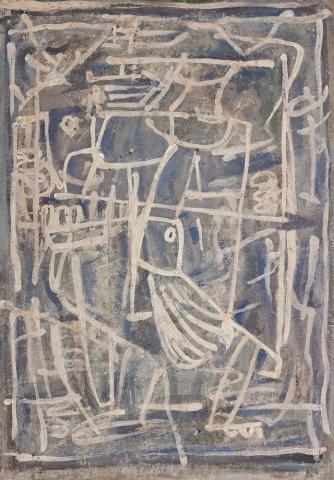WARRIOR, c.1955
IAN FAIRWEATHER
gouache on cardboard
52.0 x 37.0 cm
signed with initials upper left: I F (inverted)
Macquarie Galleries, Sydney
Private Collection, Sydney, acquired from the above on 27 February 1961
Christie's, Sydney, 3 October 1972, lot 71, as 'The Hunters'
Villiers Gallery, Sydney, as ‘Ligurion’ (label attached verso)
Alan Boxer Collection, Melbourne and Canberra, acquired from the above in March 1973
Christie's, Melbourne, 2 May 2002, lot 13, as 'Warrior'
Niagara Galleries, Melbourne (label attached verso)
Private Collection, Sydney, acquired from the above
Blue Chip V: The Collectors' Exhibition, Niagara Galleries, Melbourne, 4 – 29 March 2003, no. 22, as 'Warrior' (illus., in exhibition catalogue)
Ian Fairweather’s Warrior, c.1955 allies the power of abstraction with figuration to create a work of immense energy and fascination. Restless calligraphic lines keep the composition in constant movement, extended through the washes of paint and evoking the passion of battle and heroic endeavor. Yet, it could, just as effectively and satisfyingly, be read as an abstraction, of bravura and refinement, balance and counter balance, lines straight and curved. The colour scheme is all the more arresting through the use of a restricted palette, handled with élan. And yet the figurative and the abstract can be enjoyed simultaneously as both concepts exchange and interchange adding intreaguing dialogue to the masterly painting. In Warrior, influences Aboriginal, oriental and western harmonize in the creation of a vision individual and commanding in its authority. Each contributes through their differences and their harmony. The multi-view point, for example, creates lines flat and in profile. And the flatness of the picture plane yields to an inner depth, the material leading to the spiritual, so strongly felt in all Fairweather’s art.
It was a time of significant development and immense creativity for Fairweather, having settled in 1953, on Bribie Island off the Queensland coast to live hermit-like and paint to his satisfaction. The years witnessed the output of such masterpieces as Anak Bayan, 1957, in the collection of the Art Gallery of New South Wales, Sydney; Allelujah, 1958, in the National Gallery of Victoria, Melbourne; Monastery, 1960, in the National Gallery of Australia, Canberra; and Epiphany, 1961 – 62, in the Queensland Art Gallery, Brisbane. Closer to the time of our painting are Birdcage, 1955 (Deutscher and Hackett, 28 November 2012, lot 15), Kangaroo Hunt, 1955 (Art Gallery of South Australia, Adelaide), The Circus, c.1956, (National Gallery of Victoria), and Roi Soleil, 1956-57, (Art Gallery of New South Wales). While the influence of Australian Aboriginal art is more pronounced in the two former paintings, they all touch upon the universal in different ways. Living images, usually the human figure, are constantly present during these years, present not so much as individuals, but as individually conceived and delineated. Laurie Thomas summed up Fairweather’s originality perfectly when writing in Art and Australia some years ago. ‘He paints what he sees. But what he sees nobody else had seen until now’.1
1. Thomas, L., ‘Ian Fairweather’, Art and Australia, Sydney, vol. 1, no. 1, May 1963, p. 35
DAVID THOMAS
